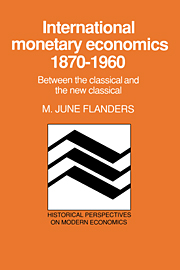Book contents
- Frontmatter
- Contents
- Preface
- 1 Preliminaries
- 2 Stream P
- 3 The beginnings of the neoclassical tradition
- 4 The locus classicus of the neoclassical position
- 5 The Macmillan Committee
- 6 A second diversion: Keynes and the Macmillan Committee
- 7 The anti-neoclassicals
- 8 Indian currency and finance: a tract on monetary reform
- 9 A treatise on money
- 10 Late Keynes: towards Bretton Woods
- 11 The crisis writers
- 3 Stream F
- 4 The confluence
- Ex post
- Bibliography
- Index
3 - The beginnings of the neoclassical tradition
Published online by Cambridge University Press: 12 October 2009
- Frontmatter
- Contents
- Preface
- 1 Preliminaries
- 2 Stream P
- 3 The beginnings of the neoclassical tradition
- 4 The locus classicus of the neoclassical position
- 5 The Macmillan Committee
- 6 A second diversion: Keynes and the Macmillan Committee
- 7 The anti-neoclassicals
- 8 Indian currency and finance: a tract on monetary reform
- 9 A treatise on money
- 10 Late Keynes: towards Bretton Woods
- 11 The crisis writers
- 3 Stream F
- 4 The confluence
- Ex post
- Bibliography
- Index
Summary
My interpretation of the neoclassical doctrine is, to refresh the reader's memory, that it is the classical model to which has been added both the shortterm international capital mobility required to finance imbalances and the responsiveness of domestic economic activity, hence the trade balance, to changes in the rate of interest.
I first discuss Bagehot's Lombard Street, the origin, or precursor, of the neoclassical position. Secondly, some attention must be given to Marshall's famous statement to the Gold and Silver Commission. This will be followed by a few of the many summary statements of what that position was supposed to have been, and thence to a more detailed analysis of the neoclassical approach, as represented by the Cunliffe Report and subsequent discussions.
Bagehot
Walter Bagehot's Lombard Street, A description of the money market, published in 1873, is a tract, a policy platform, and a “money and banking textbook” combined, and elegantly written besides. Its theme appears early on: “Money will not manage itself, and Lombard street has a great deal of money to manage” (Bagehot 1873: 20). Lombard Street is the financial center of London, London is the financial center of Britain, Britain is the center of the world, and the Bank of England must manage Lombard Street. This is his message. Note the emphasis on the word and the concept “manage”. He does not deal exclusively, or even primarily, with foreign drains (nor does he really spell out an adjustment mechanism vis-à-vis other countries).
- Type
- Chapter
- Information
- International Monetary Economics, 1870–1960Between the Classical and the New Classical, pp. 49 - 66Publisher: Cambridge University PressPrint publication year: 1990



